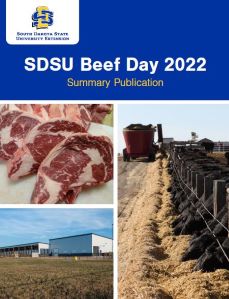
SDSU Beef Day 2022 Summary Publication
Document Type
Article
Publication Date
1-22-2022
Abstract
Study Description:
Frozen-thawed semen from five bulls previously identified as high (48.1% and 47.7%, bulls A and B, respectively), intermediary (45.5%, bull C) or low (43.1% and 40.7%, bulls D and E, respectively) fertility, based on pregnancy per AI, were evaluated with several laboratory measures. Measures included total motility, sperm plasma membrane integrity (viability), acrosome integrity, reactive oxygen species (ROS), mitochondrial membrane energy potential (mito-potential), zinc signatures (signatures 1 to 4), and CD9 protein populations at pre-wash, post-wash, h 0 (diluted with non-capacitation media), and at 0, 3, 6, and 24 h after dilution with capacitation media and incubation at 37 ºC. Data were analyzed using the GLIMMIX procedure of SAS for repeated measures with bull, time, and the interaction as fixed effects. Bull by time interaction was significant (P ≤ 0.01) for total motility and viability. There tended (P = 0.06) to be a bull by time interaction for zinc signatures 1 + 2 combined. There was a significant effect of bull (P ≤ 0.03) for viability, viable sperm with disrupted acrosome, zinc signatures 1, 2, and 1 + 2, viable CD9- (CD9 negative), and dead CD9+ (CD9 positive). High and intermediary field fertility bulls had greater (P ≤ 0.04) percentages of viable sperm, zinc signature 2, and zinc signature 1 + 2 compared to low fertility bulls. High and intermediary fertility bulls had decreased (P ≤ 0.05) percentage of dead CD9+ compared to low fertility bulls. There was or tended to be a positive correlation between pregnancy per AI and viability (P = 0.10; r = 0.81), zinc signature 2 (P = 0.04; r = 0.89), and zinc signature 1 + 2 (P = 0.10; r = 0.80).
Pages
10
Publisher
South Dakota State University
Rights
© 2022 South Dakota Board of Regents
Recommended Citation
Zoca, Saulo Menegatti; Geary, Thomas W.; Zezeski, Abigail L.; Kerns, Karl C.; Dalton, Joseph C.; Harstine, Bo R.; Utt, Matthew D.; Cushman, Robert A.; Walker, Julie; and Perry, George, "Use of Sperm In Vitro Capacitation and Flow Cytometry to Estimate Bull Fertility" (2022). SDSU Beef Day 2022 Summary Publication. 12.
https://openprairie.sdstate.edu/sd_beefday_2022/12
